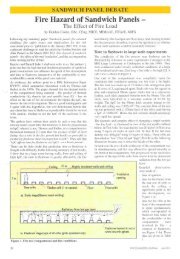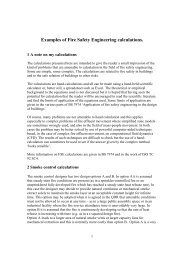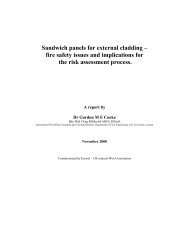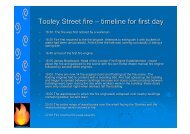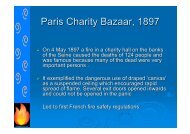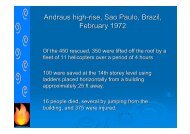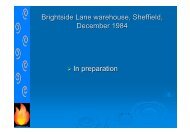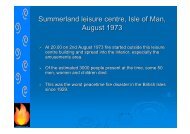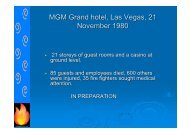You also want an ePaper? Increase the reach of your titles
YUMPU automatically turns print PDFs into web optimized ePapers that Google loves.
<strong>The</strong> <strong>Great</strong> <strong>fire</strong> <strong>of</strong> <strong>London</strong>,<strong>September</strong> <strong>1666</strong>‣ Fire started in Baker’s s house in earlymorning.‣ It spread down to the riverside wharfsand, driven by a strong easterly wind,reached as far as Chancery Lane in the 3day duration.‣ One person was known to have died inthe incipient <strong>fire</strong>.
St PaulsTower‣ White area near river is area affected by <strong>fire</strong>. It consumed about t onethird <strong>of</strong> the city including St Pauls church, the Guildhall and old o<strong>London</strong> Bridge.‣ It reached westwards to Chancery Lane and eastward to the Tower<strong>of</strong> <strong>London</strong>.‣ It also spread across the river to Southwark but to an extentunknown. Some 50 churches and 13000 houses were destroyed.‣ Much crime was committed. At the time <strong>of</strong> the <strong>fire</strong> people were stillrecovering from <strong>The</strong> <strong>Great</strong> Plague <strong>of</strong> the previous year.‣ <strong>The</strong> number <strong>of</strong> fatalities is not accurately recorded but thought to beless than half a dozen. But much material damage was done.
‣ <strong>London</strong> houseconstruction thoughtto be typical <strong>of</strong> thetime. Timber framecoated with tar.‣ Houses were closetogether and <strong>fire</strong>could spread easily.‣ Fire fighting was bya human chain <strong>of</strong>buckets <strong>of</strong> waterand 1m long squirts.‣ Squirts were onlyeffective for verysmall <strong>fire</strong>s.
<strong>Great</strong> Fire <strong>of</strong> <strong>London</strong>‣ <strong>London</strong> and <strong>London</strong> Bridge, 1640
Day 3Day 2Day 1<strong>London</strong> Bridge‣ Black boundary lines show speed <strong>of</strong> spreadover three days – it spread against a strongwind by radiation up to the Tower <strong>of</strong> <strong>London</strong>‣ <strong>London</strong> bridge was burnt down
‣ Principles <strong>of</strong> manual pumpers developed after the <strong>Great</strong> Fire <strong>of</strong><strong>London</strong>.‣ Following the Parish Pumpers Act in 1708, which required theestablishment <strong>of</strong> <strong>fire</strong> brigades, larger manual pumps weredevised which could be pulled along on four wheels and thesestill relied on the piston and cylinder principle‣ <strong>The</strong> largest pump required 40 men to operate the handles.‣ Often these machines had to be abandoned because theywere placed too close to the <strong>fire</strong> and caught <strong>fire</strong>.‣ In Amsterdam 50 ft lengths <strong>of</strong> leather hose had beendeveloped which could be connected together allowing thehose to be taken inside a building or onto the ro<strong>of</strong>, or enablingthe <strong>fire</strong> engine to be positioned further away from the <strong>fire</strong>, buthose was not in use in <strong>London</strong> at the time <strong>of</strong> the <strong>Great</strong> Fire



